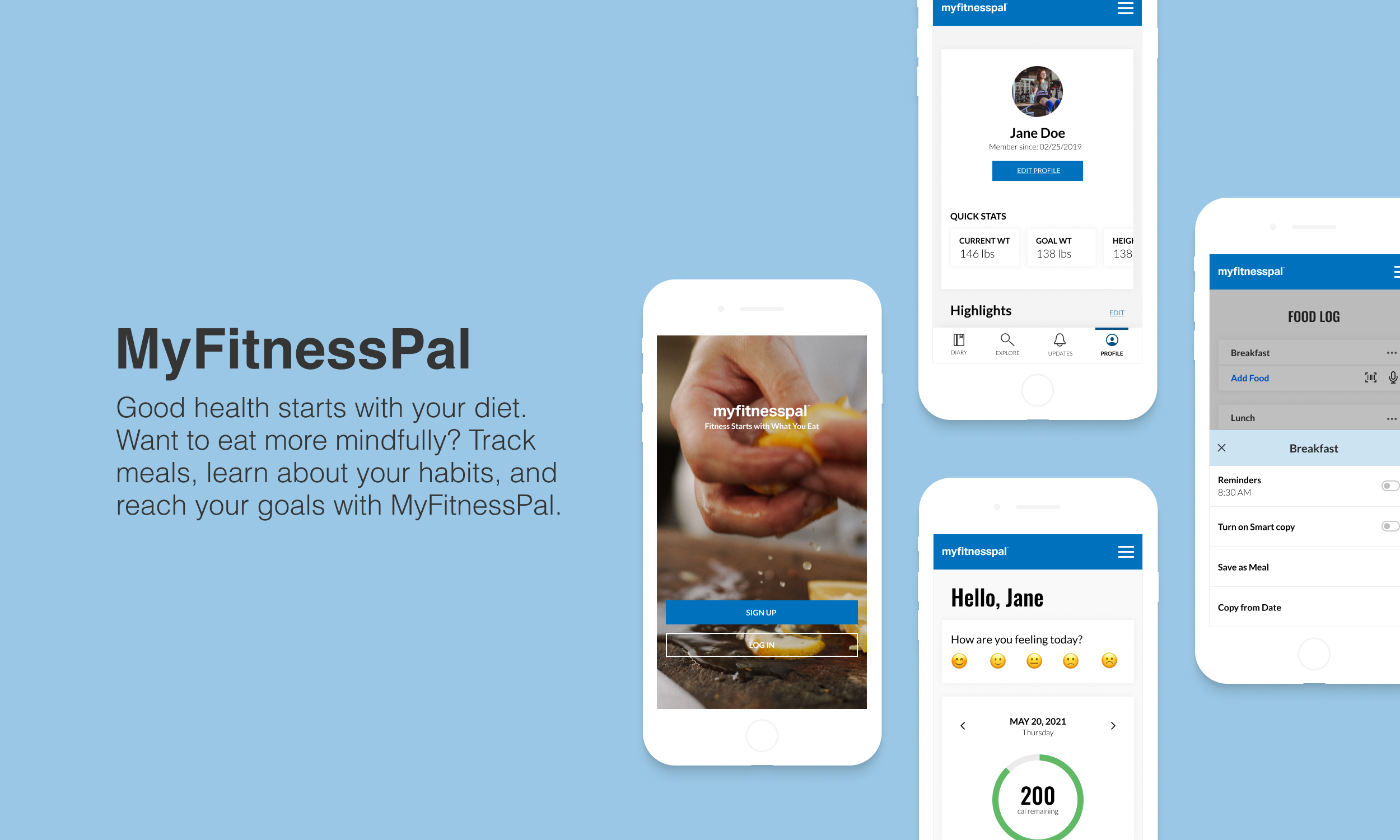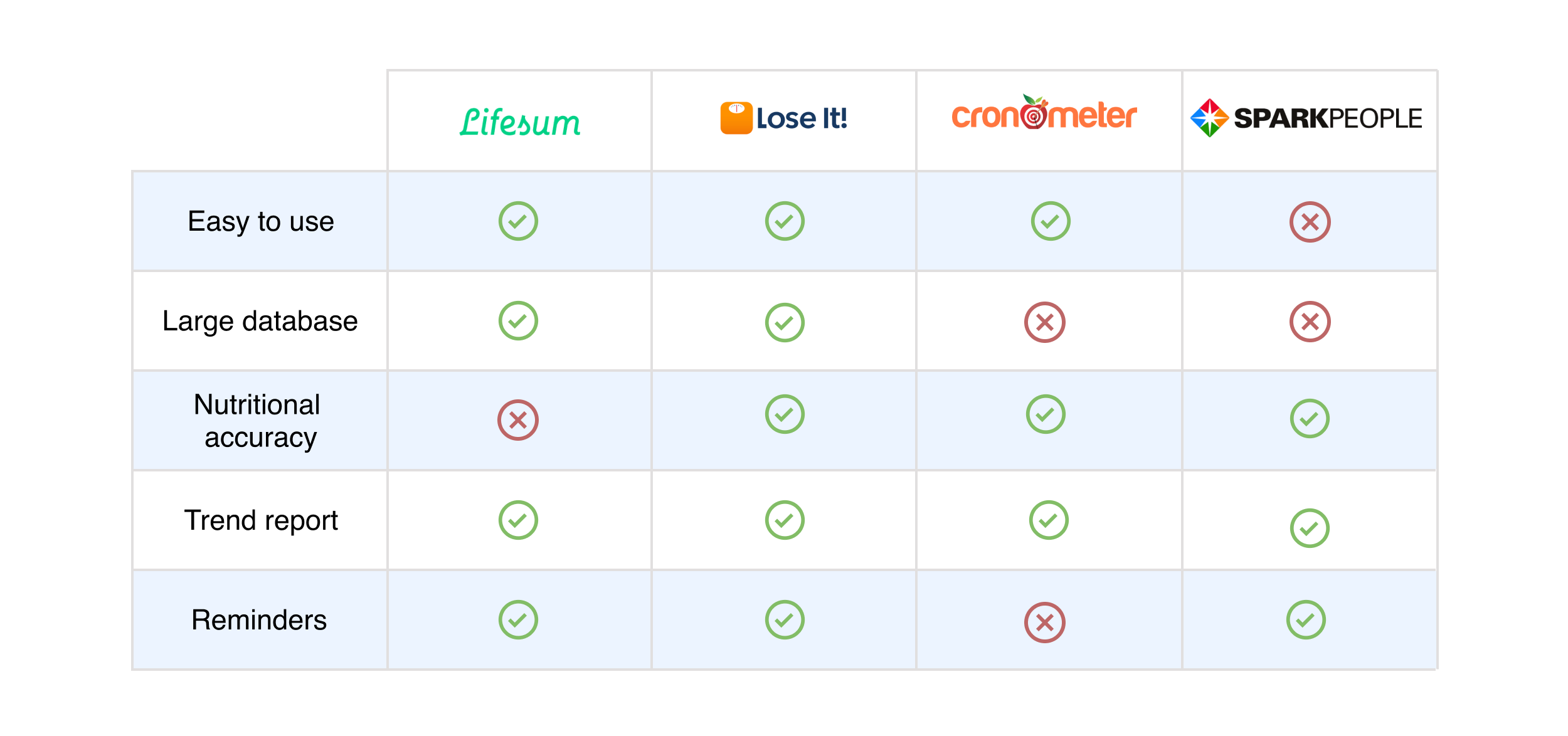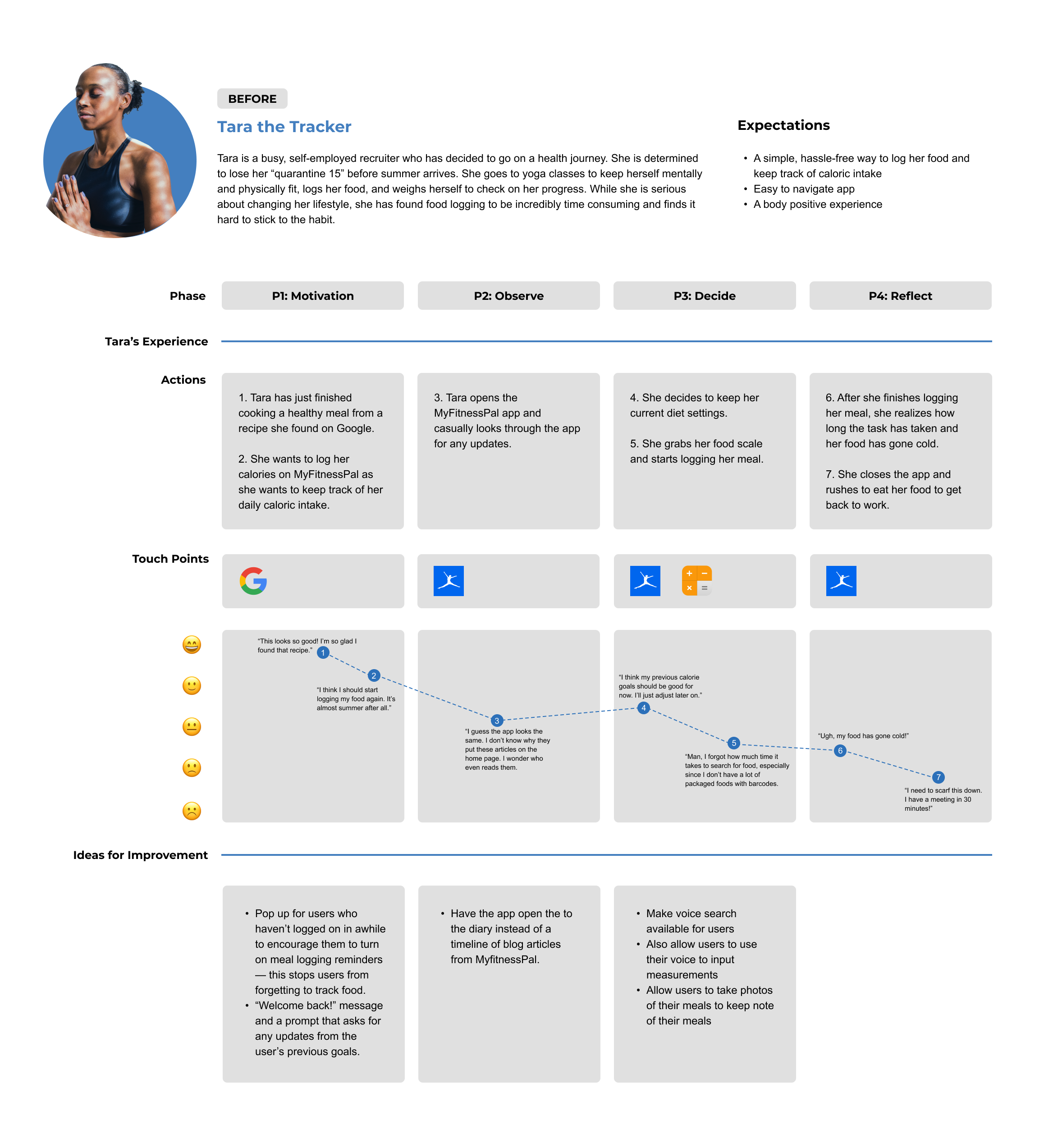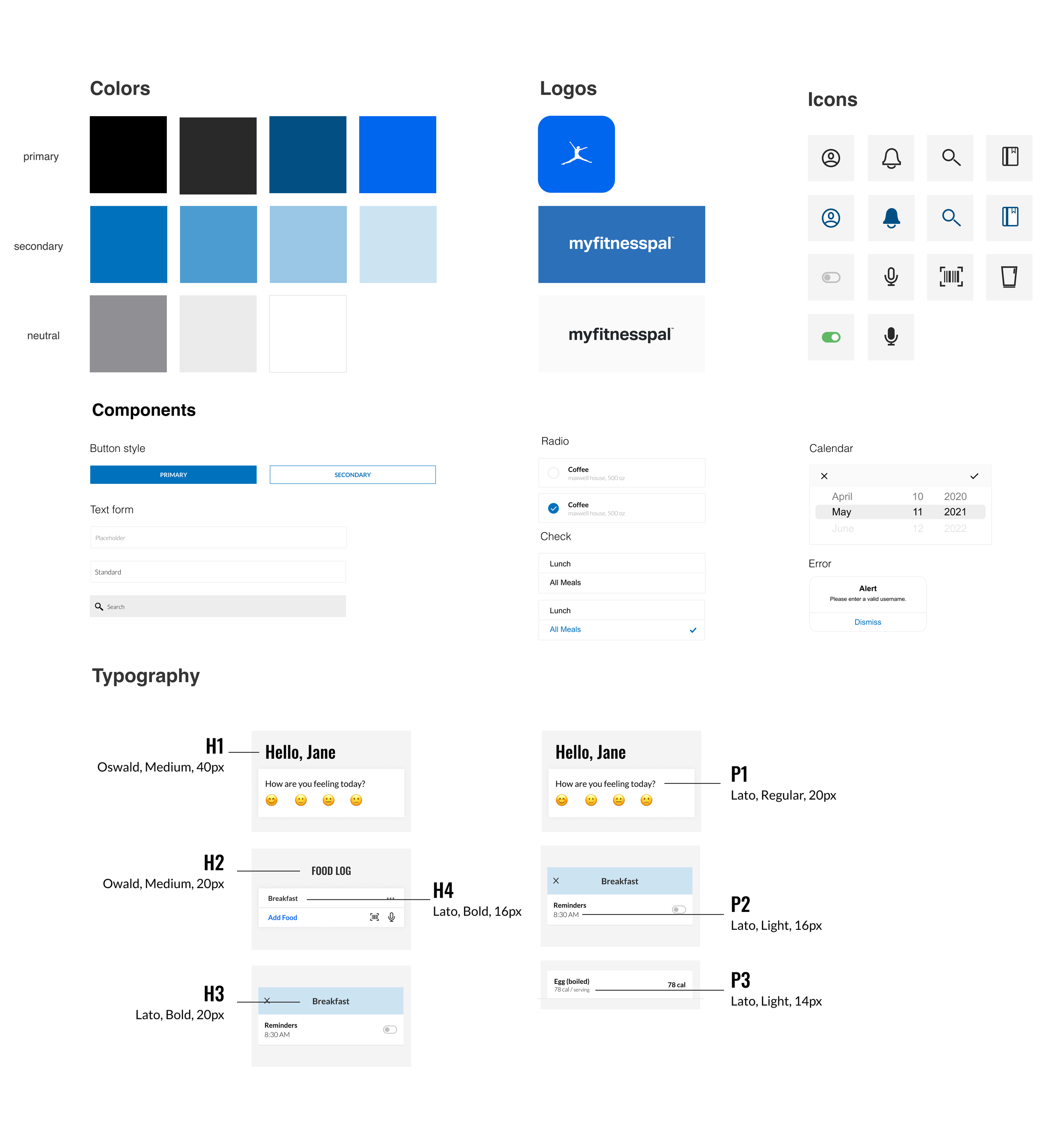MyFitnessPal
TIMEFRAME
4 weeks
ROLE
Research
Prototyping
Visual Design
Usability Testing
Project Management
PLATFORM
Mobile
TEAM
Solo
*This is a conceptual project completed as part of my design portfolio.
OVERVIEW
MyFitnessPal users use the app for support, accountability, and to save time when tracking their daily meals. My goal for the project was to improve users’ meal logging experience and increase the efficiency and effectiveness of the app.
PROBLEM
Food journalers lose the habit of journaling because they find it time-consuming, tedious, and sometimes forget to journal.
A food diary or journal is a useful tool to get a better understanding of eating habits and patterns. It can be an effective method for tracing food consumption and can support a variety of goals, including weight loss, healthier food choices, detecting deficiencies, identifying allergies, and determining foods that trigger other symptoms. One weight loss study with nearly 1,700 participants found that those who kept a daily food journal lost twice as much weight as those who kept no records (Hollis, Jack F et al 2008). While it’s a proven method, it has been considered difficult and little work has documented the challenges people experience with food journals (Hollis, Jack F et al 2008). This sparked the question: what were the biggest challenges people faced with food journaling?
SOLUTION
Voice technology can make meal logging easier, more efficient, and disrupt barriers to reliable food entry.
WHITE PAPER RESEARCH
What were the biggest challenges people faced with food journaling?
One of the significant barriers to reliable food entry was the effort required to journal (Cordeiro et al., 2015). The majority of participants in the study have reported significant challenges that sometimes lead them to abandon journaling altogether. Other challenges they’ve experienced included:
Concerns for the reliability of the extensive database
Eating context (food prepared by others or consuming various food over an extended time)
Simply losing the habit of journaling
The contrasting difficulty of meal entry
COMPETITIVE ANALYSIS
I studied 4 of the most well known food tracker apps to find any similar themes that I can bring to MyFitnessPal. While all four apps had similar features to MyFitnessPal, some didn’t have as large of a database, had no reminders, had bad UI, and weren’t as easy to use.
None of the most popular food trackers had a voice feature for inputting daily meals, which became my opportunity for the solution. This also allowed MyFitnessPal to have a unique feature that other trackers did not provide.
Reminders also presented another opportunity for MyFitnessPal to differentiate itself from other apps in the market. While the task flow for “creating a reminder” for MyFitnessPal is shorter and less confusing than the other apps, improvements can be made to shorten the flow.
USER SURVEYS + INTERVIEWS
Participants found food tracking to be time consuming and eventually felt unmotivated to continue.
I explored the participants’ past food tracking experience to get a complete picture of what their goals were when using the app, why they stopped, and if they would consider using food tracking apps again. As much as 58% of the participants started food tracking to help them lose weight, about 25% aimed to be stronger and gain muscle, and 16% just wanted to be healthier overall.
When asked about the reason they stopped food tracking, 50% said they didn’t always remember to track food while another 50% thought the task was too time consuming. The survey and interviews provided more insight to peoples’ experience with food tracking apps and the results aligned with the research.
PERSONA
Using the data from my survey and interview participants, I created Tara the tracker—a self-employed recruiter who decided to go on a healthy journey. One of her immediate goals is to lose the weight she gained over the pandemic.
To get a better understanding of the pain points Tara experiences and when she experiences them in the process, I created a customer journey map. In this scenario, I found that Tara has the most difficult time with tracking food when she’s in a rush and when she uses food without any barcodes. In phase 1-3 of Tara’s journey, there are improvements that can be made to make the experience smoother.
HOW MIGHT WE…
…make food tracking less time consuming for people with weight loss goals?
Based on the data from the research, surveys, and interviews, I needed to focuses on two main tasks: food tracking through voice input and food logging reminders.
Why voice input?
Voice recognition has become a key part in our communication. In fact, in a survey performed by Google about voice assistance, as much as 72% of people who own a voice-activated speaker say that their devices are often used as part of their daily routine. As more and more people are getting comfortable with speaking to their devices, the more this trend is set to catch on.
In 2016, MIT researchers developed a voice-controlled calorie counter that allowed users to verbally describe the contents of a meal. According to Susan Roberts, director of the Energy Metabolism Lab at Tufts’ USDA-sponsored Jean Mayer Human Nutrition Research Center on Aging, “A spoken-language system that you can use with your phone would allow people to log food wherever they are eating it, with less work. As I see it, we need to come up with something that really isn’t much work, so it isn’t an extra burden in life.”
Food logging is a crucial feature of MyFitnessPal. Imagining ways to make this feature more efficient proved to be complex because of users’ habits of logging food through search by typing. To optimize the feature without disrupting the users’ preferences, I made the additional feature option visible. This flexibility allowed users the freedom to pick the process that works the best for them.
IMPROVEMENTS
Typical users are up to five times more productive when they can speak commands or use voice recognition instead of typing. While this can improve efficiency, it is not something that would revolutionize the experience that users are already accustomed to. It was important for the new feature to be a replacement, but rather a new mode of interaction.
User testing was conducted through Maze and it provided some great feedback that I was able to incorporate into the final designs. I asked usability testing participants to complete two simple tasks: adding a reminder and using voice search to log a meal.
THE FINAL SCREENS
The final product
Style guide
So What's Next?
CONCLUSIONS + LESSONS LEARNED
Further user testing can be done to understand how users will interact with voice input and reminders. Some key metrics to keep track of would the amount of users that actually use either of the features and how often. Asking for feedback from users would also be beneficial to improving the overall user experience on the app.
Although this was the second project I completed for DesignLab, I still learned so much about the UX process.
Find out what users actually need: I learned the importance of finding what users actually need. At the beginning of the project, I was focused on creating a meal sharing feature. When I scoured the MyFitnessPal forums, there was enough evidence to support the need for a meal sharing feature. However, after my survey, I realized that users actually just wanted to make the task of meal logging easier and they just wanted to stop forgetting it.
Explore many solutions and iterate as much as you can: I think I could’ve explored more ways that food logging can be more efficient. Due to the time constraints of the project, I wasn’t able to give the exploration stage as much time as I wanted to! Going forward, I would explore more options at the beginning stages of the project and test more solutions!













